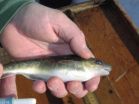The projects build upon ongoing research conducted in epilepsy patients who had the interfaces temporarily placed on their brains and were able to move cursors and play computer games, as well as in monkeys that through interfaces guided a robotic arm to feed themselves marshmallows and turn a doorknob.
"We are now ready to begin testing BCI technology in the patients who might benefit from it the most, namely those who have lost the ability to move their upper limbs due to a spinal cord injury," said Michael L. Boninger, M.D., director, UPMC Rehabilitation Institute, chair, Department of Physical Medicine and Rehabilitation, Pitt School of Medicine, and a senior scientist on both projects. "It's particularly exciting for us to be able to test two types of interfaces within the brain."
"By expanding our research from the laboratory to clinical settings, we hope to gain a better understanding of how to train and motivate patients who will benefit from BCI technology," said Elizabeth Tyler-Kabara, M.D., Ph.D., a UPMC neurosurgeon and assistant professor of neurological surgery and bioengineering, Pitt Schools of Medicine and Engineering, and the lead surgeon on both projects.
In one project, funded by an $800,000 grant from the National Institutes of Health, a BCI based on electrocorticography (ECoG) will be placed on the motor cortex surface of a spinal cord injury patient's brain for up to 29 days. The neural activity picked up by the BCI will be translated through a computer processor, allowing the patient to learn to control computer cursors, virtual hands, computer games and assistive devices such as a prosthetic hand or a wheelchair.
The second project, funded by the Defense Advanced Research Projects Agency (DARPA) for up to $6 million over three years, is part of a program led by the Johns Hopkins University Applied Physics Laboratory (APL), Laurel, Md. It will further develop technology tested in monkeys by Andrew Schwartz, Ph.D., professor of neurobiology, Pitt School of Medicine, and also a senior investigator on both projects.
It uses an interface that is a tiny, 10-by-10 array of electrodes that is implanted on the surface of the brain to read activity from individual neurons. Those signals will be processed and relayed to maneuver a sophisticated prosthetic arm.
"Our animal studies have shown that we can interpret the messages the brain sends to make a simple robotic arm reach for an object and turn a mechanical wrist," Dr. Schwartz said. "The next step is to see not only if we can make these techniques work for people, but also if we can make the movements more complex."
In the study, which is expected to begin by late 2011, participants will get two separate electrodes. In future research efforts, the technology may be enhanced with an innovative telemetry system that would allow wireless control of a prosthetic arm, as well as a sensory component.
"Our ultimate aim is to develop technologies that can give patients with physical disabilities control of assistive devices that will help restore their independence," Dr. Boninger said.
###
About the UPMC Rehabilitation Institute
The UPMC Rehabilitation Institute combines clinical care and research to help patients regain independence and enhance their quality of life following debilitating illnesses or injuries such as stroke, spinal cord injury and traumatic brain injury. The Institute's academic partner, the Department of Physical Medicine and Rehabilitation at the University of Pittsburgh School of Medicine, is ranked No. 2 in research funding from the National Institutes of Health (NIH) among physical medicine and rehabilitation programs across the country.
The largest rehabilitation provider in western Pennsylvania, the Institute serves as the hub of a UPMC network of more than 70 rehabilitation facilities. In June 2009, the Institute opened a newly renovated, 76-bed center at UPMC Mercy, offering an unparalleled expansion of specialized services for the most traumatic and complicated injuries of the brain or spinal cord, as well as for strokes. This transition of services to UPMC Mercy makes the Institute the region's only rehabilitation facility with an on-site Level 1 Trauma Center. For more information about the Institute, visit http://www.upmc.com/RehabInstitute.
About the University of Pittsburgh School of Medicine
As one of the nation's leading academic centers for biomedical research, the University of Pittsburgh School of Medicine integrates advanced technology with basic science across a broad range of disciplines in a continuous quest to harness the power of new knowledge and improve the human condition. Driven mainly by the School of Medicine and its affiliates, Pitt has ranked among the top 10 recipients of funding from the National Institutes of Health since 1997 and now ranks fifth in the nation, according to NIH data for 2008 (the most recent year for which the data are final).
Likewise, the School of Medicine is equally committed to advancing the quality and strength of its medical and graduate education programs, for which it is recognized as an innovative leader, and to training highly skilled, compassionate clinicians and creative scientists well-equipped to engage in world-class research. The School of Medicine is the academic partner of UPMC, which has collaborated with the University to raise the standard of medical excellence in Pittsburgh and to position health care as a driving force behind the region's economy. For more information about the School of Medicine, see www.medschool.pitt.edu.
About the Department of Neurological Surgery
The University of Pittsburgh Department of Neurological Surgery is nationally and internationally recognized for innovative research, high-quality training programs, and expert patient care. The department was started more than 60 years ago, and today is the largest academic neurosurgical provider in the United States, performing more than 11,000 procedures at UPMC annually.
UPMC neurosurgeons collaborate to develop treatment options -- including a number of surgical and non-surgical modalities -- based on the individual needs of each patient. Facilities include the most technologically advanced equipment, including modern surgical microscopes, advanced image-guided brain and spine navigational tools, state-of-the-art monitoring techniques that can improve patient outcomes by reducing operative complications, risk of disability, and post-operative recovery times.
Statement "A" (Approved for Public Release, Distribution Unlimited)
END


